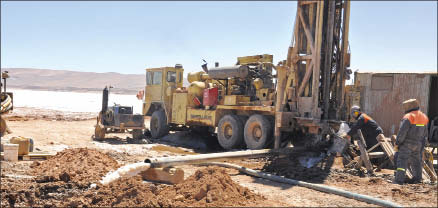Lithium One (LI-V) is fast-tracking its Sal de Vida lithium and potash project at Salar del Hombre Muerto in Argentina based on encouraging economics that sketch out the project’s huge potential.
The junior recently released a positive preliminary economic assessment (PEA) for Sal de Vida, which envisioned 25,000 tonnes of lithium carbonate and 107,000 tonnes of potash produced per year by 2015.
The project could rake in more than US$200 million a year in revenue, of which 70% would come from lithium, and the rest from potash. Lithium One says the project should start generating cash the same year it comes online.
Sal de Vida has an estimated 40-year mine life from its current inferred resources.
The project hosts a National Instrument 43-101 compliant inferred resource of 5.4 million tonnes of lithium carbonate equivalent and 21.3 million tonnes of potassium chloride equivalent, with average grades of 695 milligrams per litre (mg/L) lithium and 7,590 mg/L potassium.
Paul Matysek, Lithium One’s CEO and a founding director, says that even if only a majority of the current resource is upgraded, it would yield a very long mine life.
“We only really touched 65% of the area that we have,” he says. “But what we have already, if we could convert to measured and indicated, we’d have fifty years worth of annual supply of lithium.”
Finding more lithium is not going to be a problem, Matysek says, before explaining that the company is infill drilling the resource to reclassify it, along with tweaking the project’s metallurgy, lithium recoveries and building an engineering team.
Based on an 8% discount, the project’s pre-tax net present value (NPV) is US$1.06 billion, with a pre-tax internal rate of return of 28%. Payback is pegged at around four years. At a higher discount rate of 10%, the NPV drops to US$758 million.
The junior’s Argentine crown jewel comes with a price tag of US$365 million — a cost the junior isn’t fretting about. It has the project funded through feasibility by its Korean partners, who will also foot their share of the start-up cost.
Once the project is built, running it shouldn’t be a problem, the company says. It estimates the annual revenue from potash alone could cover the total operating expenses of US$57.8 million each year.
The individual costs to produce a tonne of lithium carbonate and potassium chloride are US$1,537 and US$184, respectively.
Matysek says the project’s relatively low start-up costs will help propel it into production. As an emerging producer, he says, “You want to be two things: low cost to go into production and low cost on an operating basis.”
He explains the strong NPV, net cash flows and low production costs for lithium carbonate are a result of the project having a near-surface resource that makes it amenable to low-cost extraction and conducive to evaporation processing.
To harvest the goods, the company intends on using a conventional evaporation process similar to that of lithium heavyweights’ Sociedad Quimica y Minera at Salar de Atacama in Chile, and FMC (FMC-N) at its new potash circuit at the nearby Fenix lithium project.
The PEA considered the brine being pumped from production wells to three different sets of ponds, where magnesium is eliminated and halite (common salt) is precipitated, Patrick Highsmith, the company’s president and COO, explains in an email to The Northern Miner. He goes on to say, “as the potassium and lithium are enriched through evaporation, potash precipitates in the last set of ponds. The potash is harvested and separated from halite and other impurities through a flotation process. A final highly concentrated brine is pumped into the lithium carbonate plant where boron and trace calcium and magnesium are removed before crystallizing lithium carbonate.”
The company predicts that the process from start of evaporation to first production will take nine months.
Given the hefty $125-million cost of building evaporation ponds, among other expenses, Lithium One has spread its financial burden by partnering up with KORES, LG International and GS Caltex. The Korean consortium has agreed to provide up to US$15 million for the feasibility study, which is expected out by mid-2012. In return, it can earn a 30% interest in the project.
As a joint-venture partner, the Korean consortium can buy 30% of the lithium products produced from Sal de Vida at market prices, which it can increase to 50%.
The consortium will also be responsible for guaranteeing the project will be built, and for securing the debt component of Sal de Vida’s $356-million capital cost. Matysek predicts the debt ratio should range between 60% and 70%. The exact ratio has yet to be finalized.
And to cover its portion of the bill, likely without stock dilution, the company’s CEO says it has plenty of avenues. “There is a lot of optionality around how to finance it. We are very cognizant about what out role is, and how much we need to do,” Matysek says. Some of those options may include issuing potash royalties or selling its interest in the James Bay spodumene project in Quebec. Galaxy Resources (GXY-A) can earn up to 70% of James Bay by funding it through feasibility.
While Lithium One will start looking at these alternatives in a year’s time, Matysek says for now the company has its nose to the grindstone to release a definitive feasibility for Sal de Vida, sort out debt ratios with its partners and line up potash and lithium sales agreements.
He adds, “We have the luxury of basically a year to do all those things, knowing we have the [feasibility] financing in place. It’s pretty exciting, and we have the optionality.”
Following the PEA news released on Oct. 5, the company’s share rose 2.5% to 80¢. The next day, the stock gained another 7.5% to close at 86¢, within a 52-week trading range of 73¢–$1.85. The junior has 60.7 million shares outstanding, of which Matysek holds 4.1 million.


Be the first to comment on "Strong economics for Lithium One’s Sal de Vida"